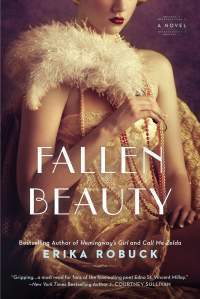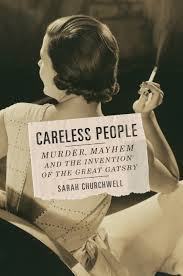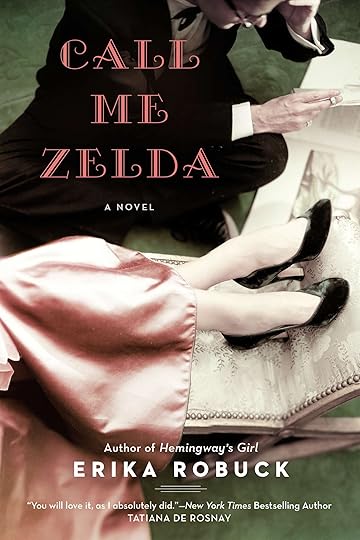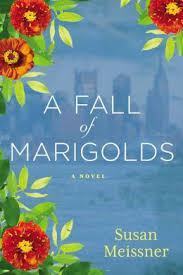Erika Robuck's Blog, page 13
April 1, 2014
National Poetry Month Giveaway
First Fig
My candle burns at both ends;
It will not last the night;
But ah, my foes, and oh, my friends–
It gives a lovely light!
~Edna St. Vincent Millay
I have long been beguiled by the work of Pulitzer Prize winning poet, Edna St. Vincent Millay, and her life story so fascinated me that she is the subject of my most recent novel, FALLEN BEAUTY. I hope that when my readers finish the novel, they use the guide in the back to seek out some of Millay’s writings.
In honor of National Poetry Month, which begins today, I am giving away a copy of FALLEN BEAUTY. To win, please comment with your favorite poet or poem below, and please share on social media. The giveaway is open to US residents only, and ends at 9 PM EST on Thursday, April 3rd.
Here is a little on the background of FALLEN BEAUTY to tempt you to open its pages:
http://www.youtube.com/watch?v=mTsaJBpfbWY
Click here to read an excerpt of the novel.
Good Luck!


March 31, 2014
Book Review: ORPHAN TRAIN

“I learned long ago, that loss is not only probable, but inevitable. I know what it means to lose everything, to let go of one life and find another. And now I feel, with a strange, deep certainty, that it must be my lot in life to be taught that lesson over and over again.” Christina Baker Kline, ORPHAN TRAIN
Publisher Synopsis
Between 1854 and 1929, so-called orphan trains ran regularly from the cities of the East Coast to the farmlands of the Midwest, carrying thousands of abandoned children whose fates would be determined by luck or chance. Would they be adopted by a kind and loving family, or would they face a childhood and adolescence of hard labor and servitude?
As a young Irish immigrant, Vivian Daly was one such child, sent by rail from New York City to an uncertain future a world away. Returning east later in life, Vivian leads a quiet, peaceful existence on the coast of Maine, the memories of her upbringing rendered a hazy blur. But in her attic, hidden in trunks, are vestiges of a turbulent past.
Seventeen-year-old Molly Ayer knows that a community-service position helping an elderly widow clean out her attic is the only thing keeping her out of juvenile hall. But as Molly helps Vivian sort through her keepsakes and possessions, she discovers that she and Vivian aren’t as different as they appear. A Penobscot Indian who has spent her youth in and out of foster homes, Molly is also an outsider being raised by strangers, and she, too, has unanswered questions about the past.
Moving between contemporary Maine and Depression-era Minnesota, Orphan Train is a powerful tale of upheaval and resilience, second chances, and unexpected friendship.
My Recommendation
I was reluctant to read ORPHAN TRAIN because I have difficulty reading novels that depict cruelty to children in any way, as I assumed this would. Numerous recommendations on social media, however, and the fact that ORPHAN TRAIN is a #1 New York Times Bestseller inspired me to dig in, and I’m so glad I did.
The premise is based on the true history of orphans packed on trains and shipped across the country, getting off at each stop until they were adopted. Sometimes the children ended up in decent circumstances, but often they did not. Vivian is one such child, but her open and sturdy character, and the way she handles setbacks and tragedies makes her radiant with courage and tenacity. The reader can make it through because Vivian can make it through, and Kline’s swift pacing make even the most difficult situations bearable.
ORPHAN TRAIN may be a quick read, but the characters will linger long after the pages are closed. It is the kind of novel that sends the reader online searching for the history that inspired it, and it makes me want to read more from Christina Baker Kline. If you enjoy fast-paced historical fiction and strong female characters, I recommend ORPHAN TRAIN.
March 10, 2014
Review: Careless People: Murder, Mayhem, and the Invention of The Great Gatsby
“…[C]oincidence has its own beauties. Even such small historical symmetries can suggest there are patterns all around us, reminders of how expansive the possibilities truly are.” Sarah Churchwell, CARELESS PEOPLE
From the Publisher:
Since its publication in 1925, The Great Gatsby has become one of the world’s best-loved books, delighting readers across the world. Careless People tells the true story behind F. Scott Fitzgerald’s masterpiece, exploring in newly rich detail the relation of Fitzgerald’s classic to the chaotic world he in which he lived. Fitzgerald set his novel in 1922, and Careless People carefully reconstructs the crucial months during which Scott and Zelda Fitzgerald returned to New York in the autumn of 1922—the parties, the drunken weekends at Great Neck, Long Island, the drives back into the city to the jazz clubs and speakeasies, the casual intersection of high society and organized crime, and the growth of celebrity culture of which the Fitzgeralds themselves were the epitome. And for the first time it returns to the story of Gatsby the high-profile murder that provided a crucial inspiration for Fitzgerald’s tale.
With wit and insight, Sarah Churchwell traces the genesis of a masterpiece, discovering where fiction comes from and how it takes shape in the mind of a genius. Blending biography and history with lost and forgotten newspaper accounts, letters, and newly discovered archival material, Careless People is the biography of a book, telling the extraordinary tale of how F. Scott Fitzgerald created a classic and in the process discovered modern America.
My Recommendation
Imagine Scott and Zelda Fitzgerald reading the morning newspaper while nursing their hangovers, and discussing the sordid murder of a pastor and his parishioner. See how Scott sharpens his capacities to exist both “within and without” of his life–judging others and himself for their behavior, but powerless or unwilling to stop it. Experience the delicious words of Zelda adding color to the text and settling into the subconscious of her husband. Understand the fascinating workings of a national mentality and its influence on the everyday lives of its people.
Sarah Churchwell succeeds in presenting these ideas in CARELESS PEOPLE–never weighing down the reader with her meticulous research, but rather, dazzling with her ability to weave narrative from fact. Churchwell presents fresh insights on material that has been written about (almost to exhaustion) for decades, and her excitement over discoveries connecting notes from Fitzgerald, newspapers from the time, and countless historical documents and artifacts to THE GREAT GATSBY, is contagious.
If ever a book were written for Fitzgerald, Gatsby, or Jazz Age enthusiasts, CARELESS PEOPLE is that book. Seamlessly blending biography and history through a true murder mystery, CARELESS PEOPLE reveals the inspiration and influences for THE GREAT GATSBY in captivating ways. It is a book you will want to read with a pencil for underlining in one hand, and a cocktail in the other, and it would make for excellent discussion at a book club. I give CARELESS PEOPLE my highest recommendation.


March 7, 2014
Eight Ways to Make Time for Writing
My new novel FALLEN BEAUTY launched on Tuesday, and I have been overwhelmed with kind words and encouragement. It is a special thing to release a book, and I am blessed to have a network of family and friends who support me in my endeavors.
Inevitably, I get asked a question at launch time, at book clubs, on the sidelines of the hockey rink, and on social media: How Do You Do It All? Sometimes it is asked nicely, other times with suspicion, but it is always asked.
I’ve been thinking a lot about that question, and I want to qualify everything I’m about to say with the fact that I feel like I’m a mess–a Tazmanian-devil, swirling, hyper, scatterbrained mess. My house is often untidy. I’m forgetful. Sometimes I do things like throw my cell phone in the laundry basket to take downstairs, and instead of plugging it into the wall, I toss it in the washing machine and dryer with the clothes.
But that is not the answer people want to hear. They literally want to know how I balance writing and family life, with a husband and three children. As many of you know, there is no such thing as perfect balance. Sometimes I neglect my writing, other times, I neglect life. I try to alternate that time so that over time, something like balance is achieved. I also have learned how to save time, and my list below shows eight ways I save time and allot it for writing, so that I can stay on track with deadlines.
I don’t go to the gym. I have a 10 minute nightly routine I do before I go to bed.
I only watch TV I’ve DVRd while folding laundry. (Downton Abbey or Dancing with the Stars.)
I don’t take on classroom parent/PTA positions. (This is an area that I struggle with and feel judged about at times.)
I limit lunches out of the house.
I write 1000-2000 words a day. (Or revise 1000-2000 words a day.) If an average novel is around 90,000 words, you can see how a book can be written fairly quickly if there is enough discipline to write in 1000 word intervals.
I research the next book while writing the current.
I combine book tour travels with research trips.
I work at night. (Insomnia is a family curse. I have learned how to use it to my advantage.)
The bottom line is that this is a job. I happen to love my job, but it still requires discipline and a schedule. These tips might not be right for everyone, and I am certainly not saying they are how one should make time. Some of these sacrifices feel like sacrifices, but I have to make priorities that work for me.
Are any of these tips helpful to you? I would love to hear your suggestions for making time for writing.
**Photo Courtesy of BreakFreePhotography at DeviantArt.com


February 26, 2014
CALL ME ZELDA ebook deal!
From now through March 12th, as part of a BookBub promotion, CALL ME ZELDA has been discounted at major ebook retailers (Amazon, B&N Nook, Kobo, iTunes, etc…) to $2.99, and includes an excerpt of my forthcoming novel, FALLEN BEAUTY!
Please share and spread the word. This is a great deal!


February 22, 2014
Happy Birthday, Edna St. Vincent Millay
Today is poet Edna St. Vincent Millay’s birthday. This fascinating woman inspired my forthcoming novel, FALLEN BEAUTY, and she is a major character in the book. Her poetry earned her the Pulitzer Prize, and at the height of her career she sold out thousand seat auditoriums for her readings.
Here is a short trailer about how I came to write FALLEN BEAUTY:
http://www.youtube.com/watch?v=mTsaJBpfbWY
To celebrate Millay’s birthday, I’m giving away a copy of FALLEN BEAUTY. To win, please leave a comment below by 9 PM EST on 2/23 with a fact you know about Millay, your favorite poet, or if you would simply like to learn more about Millay. Please share on social media. (US residents only, please.)
Good Luck!


February 12, 2014
Book Review & Giveaway: GIRL ON THE GOLDEN COIN

From the Publisher
In 1660, the Restoration of Stuart Monarchy in England returns Frances Stuart and her family to favor. Frances discards threadbare gowns and goes to gilded Fontainebleau Palace, where she soon catches the Sun King’s eye. But Frances is no ordinary court beauty—she has Stuart secrets to keep and her family to protect. King Louis XIV turns vengeful when she rejects his offer to become his Official Mistress. He sends her to England with orders to seduce King Charles II and help him form an alliance with England. The Queen Mother likewise orders Frances to become her son’s mistress, in the interest of luring him away from the Protestant mistress he currently keeps.
Armed in pearls and silk, Frances maneuvers the political turbulence of Whitehall Palace, but still can’t afford to stir a scandal, determined to keep her family from shame. Her tactic to inspire King Charles to greatness captivates him and the two embark on a tenuous relationship. Frances survives the Great Fire, the Great Plague, and the debauchery of the Restoration Court, yet loses her heart to the very king she must control. A startling discovery will leave her with no other choice but to break his heart, while the fate of England hangs in the balance.
In the tradition of Philippa Gregory, debut author Marci Jefferson brings to life a captivating woman whose beauty, compassion, and intellect impacted a king and a nation, in Girl on the Golden Coin.
My Recommendation
It has been some time since I have been immersed in a robust, political, sexy, historical novel like Girl on the Golden Coin, so it was a delight to embark on this journey. Jefferson knows how to keep the reader turning pages, and her sensory descriptions of the rich palaces, gardens, and costumes of the time are evocative.
It was a pleasure to read about Frances Stuart and the court of King Charles II–a subject about which little is written but whose historical context is every bit as intriguing as the court of Henry VIII. Many of the supporting characters piqued my interest and left me wanting more, and I hope to see a series based around this time.
With the drama and scheming of The Tudors, the sumptuous detail of The White Queen, and the page turning scandal of The Other Boleyn Girl, Girl on the Golden Coin will quickly become a favorite of readers who love the genre. Jefferson’s debut is assured and captivating, and I look forward to reading more by this author.
The publisher provided a giveaway copy of Girl on the Golden Coin (US residents only, please.) To win, please comment below if you have any knowledge of this time in European history, or your favorite historical novel series. I will choose a winner by random drawing on Friday, February 14th, 9 PM EST. Good luck!
February 11, 2014
Author Q and A: Susan Meissner, and a Giveaway!
It’s a pleasure having award-winning novelist Susan Meissner here with me today to talk about her newest book from Penguin NAL, A Fall of Marigolds, a part historical novel, part contemporary novel set on Ellis Island in 1911 and in Manhattan a hundred years later.
1. Susan, where did the idea for this story come from?
I’ve long been a history junkie, especially with regard to historical events that involve ordinary people facing extraordinary circumstances. A couple years ago I viewed a documentary by author and filmmaker Lorie Conway called Forgotten Ellis Island; a hauntingly poignant exposé on the section of Ellis Island no one really has heard much about; its hospital. The two man-made islands that make up the hospital buildings haven’t been used in decades and are falling into ruins, a sad predicament the documentary aptly addresses. The documentary’s images of the rooms where the sick of a hundred nations waited to be made well stayed with me. I knew there were a thousand stories pressed into those walls of immigrants who were just a stone’s throw from a new life in America. They were so close they could almost taste it. But unless they could be cured of whatever disease they’d arrived with, they would never set foot on her shores. Ellis Island hospital was the ultimate in-between place – it lay between what was and what could be. A great place to set a story
2. What is the novel about, in a nutshell?
The book is about two women who never meet as they are separated by a century. One woman, Taryn, is a 9/11 widow and single mother who is about to mark the tenth anniversary of her husband’s passing. The other is a nurse, Clara, who witnessed the tragic death of the man she loved in the Triangle Shirtwaist Fire in Manhattan in 1911.In her sorrow, Clara imposes on herself an exile of sorts; she takes a post at the hospital on Ellis Island so that she can hover in an in-between place while she wrestles with her grief. She meets an immigrant who wears the scarf of the wife he lost crossing the Atlantic, a scarf patterned in marigolds. The scarf becomes emblematic of the beauty and risk inherent in loving people, and it eventually finds it way to Taryn one hundred years later on the morning a plane crashes into the NorthTower of the WorldTradeCenter. The story is about the resiliency of love, and the notion that the weight of the world is made more bearable because of it, even though it exposes us to the risk of loss.
3. What led you to dovetail the Triangle Shirtwaist Fire of 1911 with 9/11?
When I first began pulling at story threads, my first instinct was to tell a story about an immigrant struggling to remain hopeful as an unwilling patient at Ellis Island hospital. But the more I toyed with whose story this was, the more I saw instead a young nurse, posting herself to a place where every disease known and unknown showed up. It was a place like no other; a waiting place – a place where the dozens of languages spoken added to the unnatural homelessness of it. Why was she here? Why did she choose this post? Why did she refuse to get on the ferry on Saturday nights to reconnect with the real world? What kind of person would send herself to Ellis not just to work, but to live? Someone who needed a place to hover suspended. I knew something catastrophic had to happen to her to make her run to Ellis for cover. As I began researching possible scenarios, I came across the Triangle Shirtwaist Fire, which up until 9/11 was arguably the worst urban disaster to befall Manhattan. There were similarities between that fire and 9/11, including the tragic fact that many trapped workers jumped to their deaths rather than perish in the flames. For every person lost in disasters such as these, there is always his or her individual story, and the stories of those who loved them. I wanted to imagine two of those stories.
4. Are you working on anything new at the moment?
My next book is set entirely in England, mostly during The London Blitz. My main character starts out as a young, aspiring bridal gown designer evacuated to the countryside with her seven-year-old sister in the summer of 1940. Though only fifteen, Emmy is on the eve of being made an apprentice to a renowned costumer and she resents her single mother’s decision to send her away. She sneaks back to London – with her sister in tow – several months later but the two become separated when the Luftwaffe begins its terrible and deadly attack on the East End on the first night of the Blitz. War has a way of separating from us what we most value, and often shows how little we realized that value. I have always found the evacuation of London’s children to the countryside – some for the entire duration of the war – utterly compelling. How hard it must have been for those parents and their children. I went on a research trip to the U.K. in the fall of 2013 and I spoke with many individuals who were children during the war; some were separated from their parents, some were bombed out of their homes, some slept night after night in underground Tube stations, some watched in fascination as children from the city came to their towns and villages to live with them. This book explores issues of loss and longing, but also the bonds of sisters, and always, the power of love.
5. Where can readers connect with you?
You can find me at www.susanmeissner.com and on Facebook at my Author page, Susan Meissner, and on Twitter at SusanMeissner. I blog at susanmeissner.com. I also send out a newsletter via email four times a year. You can sign up for it on my website. I love connecting with readers! You are the reason I write.
Thank you, Susan. I wish you all the best with A FALL OF MARIGOLDS, which I absolutely loved!
To win an incredible giveaway gift basket, please comment below by Thursday, February 13th at 9 PM EST about your favorite Susan Meissner novel, or why you are interested in reading A FALL OF MARIGOLDS, and please share on social media. Good luck!


February 4, 2014
FALLEN BEAUTY Trailer and Giveaway
I am thrilled that there is only one month until the publication of my novel, FALLEN BEAUTY. My publisher has put together a trailer/interview about the novel, to let readers know more about the subject of the book, poet Edna St. Vincent Millay. Her writing and her life are fascinating, and I found her a captivating and challenging voice to capture.
I am excited to get the word out about FALLEN BEAUTY, and I have 2 advanced reader copies to give away. If you would like to enter for a chance to win (US residents only), please share this post on social media by Thursday, February 6th at 9 PM EST, and comment on your favorite Millay poem, or if you would simply like to know more about her. (Brace yourself: she is a wild one!)
Without further ado, let me tell you more about FALLEN BEAUTY…
http://www.youtube.com/watch?v=mTsaJBpfbWY


January 11, 2014
Book Review: THE PARIS WINTER
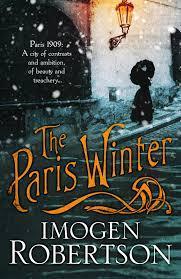
“They established themselves on the floor of Sylvie’s room, Maud pinning her oil sketching paper to a deal board to support it then choosing her tints, squeezing each onto the palette in abstemious amounts, attaching the little tin cup with its reservoir of linseed oil to its edge, setting out her hog-hair and sable brushes. As she did so, Sylvie prepared her [opium] tray with a similar satisfaction, and Maud was aware that the ritual was important to them both. Then each settled to their addiction.” Imogen Robertson, THE PARIS WINTER
Publisher Description:
A deep, dark and opulent tale of Belle Epoque Paris, and the secrets and dangers hidden beneath its luxurious facade.
Maud Heighton came to Lafond’s famous Academie to paint, and to flee the constraints of her small English town. It took all her courage to escape, but Paris eats money. While her fellow students enjoy the dazzling joys of the Belle Epoque, Maud slips into poverty.
Quietly starving, and dreading another cold Paris winter, Maud takes a job as companion to young, beautiful Sylvie Morel. But Sylvie has a secret: an addiction to opium. As Maud is drawn into the Morels’ world of elegant luxury, their secrets become hers. Before the New Year arrives, a greater deception will plunge her into the darkness that waits beneath this glittering city of light.
My Recommendation
This is a breathtaking novel, or rather, breath stealing.
From the quiet dignity of the art school, to the hazy chambers of the rich and careless in 1909 Paris, Robertson draws the reader in with her Poe-like tale. Shocking and dark, meticulously crafted, and complex, THE PARIS WINTER, succeeds in creating a world of layered characters in a sensuous and often dangerous dance with one another, that pushes its cast to the brink of madness and back.
Interspersed throughout the text are descriptions of art from a contemporary catalogue, foreshadowing the central moments of each section with brilliant precision, and slowly instructing the reader how to view each scene as if taking in a painting, making careful use of lighting, placement, and focus.
If you enjoy chilling tales of mystery and revenge in fascinating historical settings, you will love THE PARIS WINTER. Though it is surely not for the faint of heart, I give this book my highest recommendation.



